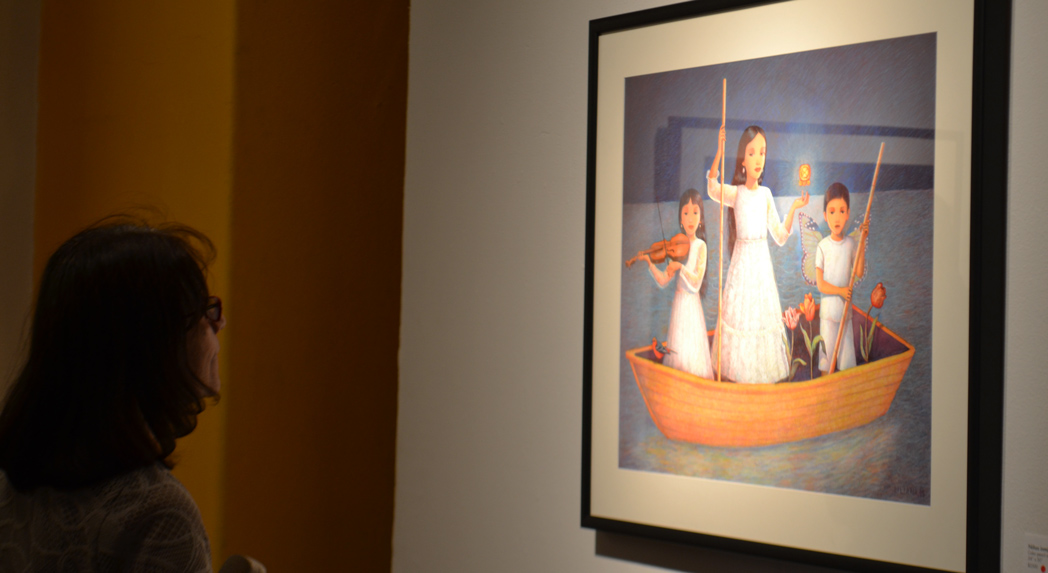Visual Arts
Part of Arte y Corazón
Since the very beginning of Esperanza, art of all kinds has been integral to our work. Over the years we have been proud to host numerous visual art exhibitions providing encouragement to local artists, while exposing San Antonio to important and otherwise-invisible national and international artists. The Esperanza features local and international artists whose work is omitted from the mainstream gaze, with group shows year-round emphasizing emerging women, queer, and people of color artists responding to issues of social & environmental justice and global concerns.
The gallery in our first building on S. Flores may have been modest, but it was an exciting place for San Antonio in the late 1980s and early 1990s, and quickly became known as a place where artists not included in mainstream venues could get their first chance. Especially for women, people of color, and queer artists, Esperanza became the home, the refuge where people felt free to express themselves honestly about issues close to their hearts, without being attacked, without being asked to “tone things down” or to self-censor their work.
In 1988, for example, Esperanza presented “The AIDS Series”, the first visual art show in San Antonio about a subject no one else wanted to talk about or address. At the opening reception, activists circulated petitions, while speakers, straight and gay, talked about the effect AIDS has had on their lives and on the lives of the people they love. While public sentiment with HIV and AIDS has changed, in 1988 “The AIDS series” was considered a very radical and controversial subject. Following the AIDS exhibit, the first Lesbian and Gay art show was exhibited at the S. Flores space and continued for almost 5 consecutive years. As independent visual art has been increasingly demonized in the U.S. especially, Esperanza has repeatedly come under attack for our visual arts programming. In June of 1993, the Esperanza was evicted the day after the opening of our annual lesbian and gay art show. To eliminate the possibility of eviction, the Esperanza purchased a building in 1994. Our gallery space tripled in size. One year after the eviction, the Esperanza held the Who We Art” exhibit to a crowd of over 800 people. For more information about the eviction please visit the Esperanza San pedro Building page to learn about how the Esperanza purchased its first building.
Since then Esperanza’s shows have expressed the visions of over 1500 local, national and international artists including: Adriana Garcia, Liliana Wilson, Kathy Vargas, Laura Águilar, Santa Barraza, Phillip Avila, Veronica Castillo, Magda Chellet, SAAKRED, Carolina Flores, Marsha Gomez, Harmony Hammond, Michael Marínez, Cesar Martinez, Lisa Mellinger, Laura Paris, Alan Pogue, Cruz Ortiz, Carlos Gutierrez Solana, Kathy Vargas, Bernica Williams, Ted Abercrombie, Bernice Appelin-Williams, Philip Ávila, Sabra Booth, Rolando Briseño, Hazel M. Browning, David Zamora Casas, Jose Chapa, Agosto Cuellar, Ana Fernandez, Anel Flores, Marsha Gómez, Ester Hernández, Lisa Mellinger, Franco Mondini-Ruiz, Peter Ortiz, Antonia Padilla, Kristy Pérez, Martha Prentiss, Elizabeth Puente, Chuck Ramírez, Angel Rodríguez-Díaz, Rosalynn Warren and Terry Ybañez. With each exhibit, Esperanza also presents pláticas, or community dialogues, in which artists, scholars, and community discuss issues raised by the works presented. Scholars have included Tomás Ybarra Frausto, Antonia Castañeda, Rudy Rosales, Cherríe Moraga, Barbara Smith, Suzanne Pharr, Angela Davis, and Betita Martinez Martinez. and many more.
The following are a few of the historic exhibitions held at Esperanza Peace & Justice Center
1988 Mujeres y Artistas
1990 ….And Justice for All
1991 Freedom of Choice
1992 Exorcising Demons
1993 Closets: Queer Experiences
1994 Who We Art
1995 Exhibición de Libre Enganche
1995 Re/Defining Lesbians: Power/Transition
1996 Engendros
1997 hope works/ trabajos de esperanza
1997 Exhibición de Libre Enganche
2004 W.A.R.R.R.
2007 ¡Qué Queer! San Antonio
2009 El Mundo Zurdo
2011 Maiz: En el umbral de la agonia – in the throes of death

